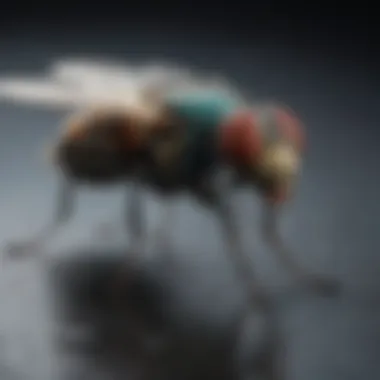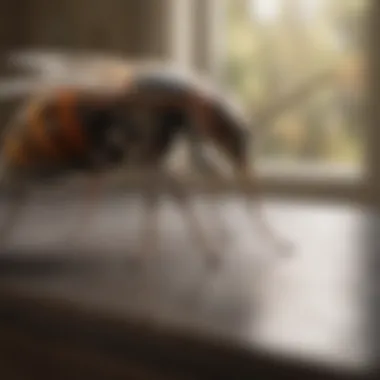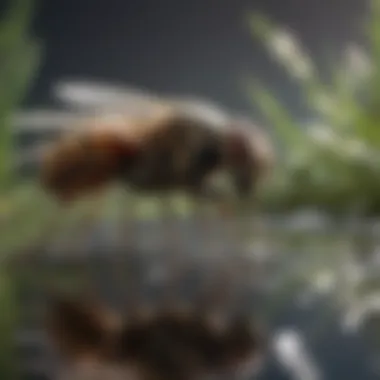Effective Strategies for Fly Insect Control


Intro
Fly insects can be a significant nuisance in both residential and commercial settings. Their presence is not only irritating but also poses potential health risks. Understanding how to effectively reduce their populations can save time and money while improving the overall environment. This guide provides a thorough exploration of strategies to manage fly insect populations, beginning with proper identification and moving into prevention, treatment, and maintenance practices.
Pest Identification
Detailed descriptions of common pests
Identifying the specific types of fly insects prevalent in your area is crucial for effective management. Common fly species include the house fly, fruit fly, and drain fly.
- House Fly (Musca domestica): Typically gray with four dark stripes on their thorax, house flies are commonly found in homes and can breed in a variety of decaying matter.
- Fruit Fly (Drosophila spp.): Small and brown, fruit flies are often found around overripe or decaying fruits and vegetables.
- Drain Fly (Psychodidae): These small, moth-like flies are usually found near drains and stagnant water. They have fuzzy bodies and wings, making them distinct.
Signs and symptoms of infestations
Recognizing the signs of a fly infestation early can help mitigate the problem. Look for the following indicators:
- Increased fly activity around food sources or waste.
- Presence of fly larvae in areas where food is not properly stored.
- Unusual maggot-like infestations in trash bins or compost areas.
Prevention Strategies
Home maintenance tips for pest prevention
Keeping your home clean and well-maintained is one of the most effective preventive measures against fly infestations. Here are some practical tips:
- Seal cracks and openings: Flies often enter homes through small gaps. Ensure that windows and doors are tightly sealed.
- Manage waste properly: Dispose of garbage regularly, and ensure that bins have tight-fitting lids.
- Clear food debris: Wipe up spills promptly and keep countertops clean to prevent attraction.
Natural deterrents and barriers
Utilizing natural repellents can help in keeping flies at bay. Consider these options:
- Essential Oils: Lavender, eucalyptus, and citronella oils can deter flies. Place bowls of these oils around your house.
- Herbs: Growing basil, mint, or rosemary near windows can also serve as natural barriers against flies.
Treatment Options
Overview of chemical vs. natural treatments
Understanding the difference between chemical and natural treatments is essential for effective pest management. Chemical treatments often provide immediate relief but come with potential side effects. In contrast, natural treatments may be slower but are often safer for households with children and pets.
Step-by-step guides for DIY treatments
If you prefer to adopt a do-it-yourself approach, here’s a simple method to create a natural fly trap:
- Gather a jar, apple cider vinegar, and plastic wrap.
- Pour a small amount of apple cider vinegar into the jar, filling it halfway.
- Cover the top with plastic wrap and secure it with a rubber band.
- Poke small holes in the plastic wrap to allow flies to enter.
This trap capitalizes on the flies' attraction to the vinegar, effectively capturing them.
"A systematic approach that combines various strategies is key to effectively reducing fly populations."
Understanding Fly Insects
Understanding fly insects is crucial for developing effective strategies to control their populations. This section sheds light on the various types of flies and their life cycles, enabling readers to identify and address fly infestations with informed approaches. By grasping the behavior and characteristics of flies, homeowners can take preventive actions and implement controls more efficiently.
Types of Flies
House Flies
House flies, Musca domestica, are among the most common fly species encountered in homes. They thrive in human environments, often found near food waste and garbage. What sets house flies apart is their ability to reproduce quickly; a single female can lay up to 1,000 eggs in her lifetime. This characteristic makes them significant contributors to fly population issues. Moreover, house flies can carry disease pathogens, presenting a potential health risk in household settings. Understanding their breeding habits encourages prompt action during infestations.
Fruit Flies
Fruit flies, known scientifically as Drosophila melanogaster, are attracted to overripe or decaying fruit. Their small size and fast reproduction rate contribute to quick population growth, posing potential nuisances in kitchens or food storage areas. A primary feature of fruit flies is their sensitivity to chemical cues, which means that effective baiting strategies may involve the use of specific scents to lure them. The recognition of their unique attraction to certain foods is vital for effective control methods.
Flesh Flies
Flesh flies, belonging to the family Sarcophagidae, are often found near decaying organic matter. They can be distinguished from other flies by their grayish body and red eyes. A notable aspect of flesh flies is that they can reproduce on carrion or decaying food, which can pose both hygienic issues and attract other pests. Their presence indicates unsanitary conditions and necessitates immediate attention to control measures since they can transmit bacteria through the decomposing matter.
Drain Flies
Drain flies, or Psychodidae, are often located in damp areas with standing water, such as sinks and drains. The distinctive feature of drain flies is their fuzzy appearance, resembling moths. They can breed in biofilm that forms in drains, making them challenging to eliminate without proper cleaning. Understanding the habitat of drain flies aids homeowners in identifying potential breeding grounds, facilitating elimination efforts.
Lifecycle of Flies
Egg Stage
The egg stage marks the initial phase in a fly's life cycle. Female flies lay eggs in preferred environments, such as compost, food waste, or moist areas. The ability to lay numerous eggs means that the potential for rapid population growth is significant. Recognizing the conditions that favor egg-laying helps in implementing proactive measures to control infestations.
Lava Stage
During the lava stage, eggs hatch into larvae, which require organic matter for nourishment. This stage is vital for development; larvae can consume considerable amounts of food waste and organic material. The presence of larvae indicates a breeding ground that is suitable for adult flies and signals the need for immediate sanitation efforts.
Pupa Stage
In the pupa stage, larvae undergo transformation into adult flies. This stage can last several days, depending on environmental factors. The pupa is often found in secluded areas, making it difficult to spot. Recognizing the significance of this stage helps in acting before adult flies emerge, potentially saving time and resources in pest management efforts.
Adult Stage
The adult stage is when flies become noticeable and begin the cycle anew by laying eggs. House flies can live up to 30 days as adults, during which they actively seek food sources and breeding opportunities. Awareness of this final stage highlights the importance of early intervention to disrupt the reproductive cycle. By effectively managing adult fly populations, homeowners can significantly reduce overall fly infestations.
Identifying Fly Insect Infestations


Identifying fly insect infestations is a crucial aspect of fly management. Understanding how to correctly identify the signs and levels of infestation can lead to more effective intervention. This not only helps in targeting specific types of flies but also minimizes the use of unnecessary treatments. Being able to promptly recognize the presence of flies can aid homeowners in taking immediate action, preventing further escalation.
Signs of Fly Presence
Visual Sightings
Observing visual sightings of flies is often the first indicator of an infestation. House flies, for instance, are commonly seen hovering around food and waste. They are typically gray with four dark stripes on their thorax. Recognizing these characteristics quickly allows for immediate steps to mitigate the problem. A key characteristic of visual sighting is the ease of detection; if flies are visible, it indicates that the infestation is at a level that demands attention.
Flies are not only annoying but can also spread diseases. Identifying them quickly is vital for health protection.
While visual sightings can provide quick insight into the presence of flies, they do have a disadvantage. Not all flies are easy to spot, especially in larger areas or during busy times. This means that homeowners should always consider other signs as well.
Unpleasant Odors
Unpleasant odors often accompany fly infestations. This aspect could be due to decaying food or waste where flies breed. The distinct smell can serve as an alert for residents, prompting them to investigate the source. Flies are attracted to these areas, confirming the presence of existing populations. The key characteristic of unpleasant odors is their ability to signal a problem before flies become visible.
The unique feature of using odors for identification is that they can reach your attention earlier than visual identification. However, unpleasant odors might also stem from other sources, which can complicate the identification process when not directly related to flies.
Attracted Areas
Identifying areas that attract flies provides critical information for managing infestations. Flies are commonly drawn to locations that offer food, moisture, or breeding sites. Common areas include garbage disposals, compost bins, and areas where food spills have occurred. Recognizing key characteristics of these attracted areas can help focus preventive measures.
The unique feature about attracted areas is that they offer insights into why flies are present, informing targeted clean-up efforts. Nevertheless, it is essential to keep in mind that while some areas may attract flies, this does not necessarily mean there is an active infestation. Only when flies are sighted or unpleasant odors are noted should one consider intervention.
Determining Infestation Levels
Monitoring Techniques
Monitoring techniques are effective for establishing the existence and severity of a fly problem. Multiple methods exist, including sticky traps, visual counts, and pheromone baiting. Utilizing these techniques helps homeowners gauge the fly population over time. The key characteristic of these techniques lies in their objectivity; they provide hard data on fly numbers, making management decisions easier.
The unique feature of effective monitoring is its capacity to reveal trends in fly activity rather than isolated incidents. However, these techniques require consistency and time, something that can be challenging in busy households.
Severity Assessment
Severity assessment involves evaluating how bad the infestation is and its implications for health and safety. This can include checking for the presence of larva and the frequency of adult fly sightings. The key characteristic of severity assessment is its role in guiding control strategies. A more severe infestation necessitates quicker and more aggressive interventions.
One unique feature of severity assessments is that they clarify the need for possibly more profound interventions rather than simple deterrents. This ensures a strategic approach but could lead to a sense of urgency that pressures homeowners into hasty actions.
Comparison with Threshold Levels
Comparing fly populations with established threshold levels is essential for understanding when to act. This method uses local data to define acceptable population limits. The key characteristic of this comparison is that it provides a baseline for decision-making. Homeowners can determine when intervention is required based on objective measures of fly populations.
The unique feature of this method is its reliance on scientific data, providing a clear rationale for action. However, not every homeowner has access to comprehensive threshold data, which may complicate personal assessments.
Identifying and assessing fly infestations effectively enables targeted interventions and creates a pathway for sustainable management solutions.
Preventive Measures
Preventive measures play a pivotal role in controlling fly populations. By focusing on these practices, homeowners can greatly reduce the risk of infestation. It is easier to prevent flies from entering homes than to eliminate them once they have settled. Implementing effective strategies can lead to healthier living environments, less reliance on chemical controls, and improved overall comfort indoors.
Sanitation Practices
Sanitation is one of the most effective tools against flies. Maintaining cleanliness across living spaces has direct implications for reducing fly attraction. Flies are typically drawn to food residues and waste. Therefore, regular sanitation practices become essential.
Regular Cleaning Routines
Regular cleaning routines help in removing potential fly breeding grounds. This means not just sweeping and mopping but also focusing on less visible areas. Dust and grime can accumulate under appliances or in corners. By focusing on these areas, one can disrupt the fly lifecycle.
Key characteristics of regular cleaning routines: They require commitment and consistency. Frequent attention to cleanliness can deter flies effectively.
Unique feature: Adhering to a schedule increases efficiency in cleaning areas that are often overlooked. However, it demands time and dedication from homeowners, which might be challenging for some.
Proper Food Storage
Proper food storage is critical in preventing fly infestations. Flies are attracted to accessible food sources. Ensure that all food items are sealed in airtight containers. This not only deters flies but also maintains food freshness.
Key characteristic: Organizing food items prevents spills and contains odors that attract flies. It is a straightforward approach contributing significantly to fly control.
Unique feature: Proper storage also reduces food wastage. On the downside, initial investments in storage solutions can be a bit high for some homeowners, but it pays off in the long run.
Waste Management
Effective waste management practices are crucial in the fight against flies. Flies are notorious for breeding in decaying organic matter. Regularly take out the trash and ensure bins are well-lidded.
Key characteristic: Waste management minimizes the chances of flies finding suitable breeding sites close to home. It creates an unfriendly environment for them.
Unique feature: Implementing proper waste disposal methods benefits overall hygiene in the home. One challenge can be ensuring the entire household adopts these practices consistently.
Physical Barriers
Beyond sanitation, physical barriers can significantly aid in controlling fly populations. These measures serve as preventative tactics, making it harder for flies to enter homes.
Insect Screens
Insect screens are a physical barrier that can help deter flies from entering. Installing them on windows and doors provides a protective layer without sacrificing airflow.
Key characteristic: They offer an unobtrusive solution for keeping flies out while allowing natural ventilation.
Unique feature: They are often cost-effective and can be installed with minimal effort. However, if not maintained regularly, holes and tears can compromise their effectiveness.
Sealing Entry Points


Sealing entry points is another effective preventive measure. Flies often find their way into homes through small cracks and gaps.
Key characteristic: This method requires attention to detail, as some entry points may not be immediately visible.
Unique feature: Sealing these gaps not only keeps flies out but can also enhance energy efficiency in homes. The downside may be the requirement of some tools and materials.
Fly Traps
Fly traps are designed to capture and reduce fly populations around the home. They can be beneficial in areas where flies are prevalent.
Key characteristic: They work actively to catch flies, providing measurable results over time.
Unique feature: Various options exist, from chemical to natural traps. It's crucial to select the right trap, as some may be more effective in certain conditions, while others can be less so.
In summary, preventive measures are essential layers in the comprehensive strategy to manage fly insect populations. These approaches involve a combination of sanitation practices and physical barriers that work synergistically to create an unattractive environment for flies.
Chemical Control Methods
Chemical control methods play a crucial role in managing fly insect populations, especially when infestations occur at significant levels. Insecticides, which are specially formulated chemicals intended to kill insects, provide a powerful means of combatting flies. Their swift effectiveness is one primary reason they are often preferred in both residential and commercial settings. By targeting the life stages of flies, these chemicals can significantly reduce their numbers and help restore hygiene to affected areas. However, alongside their benefits, considerations regarding their use, such as safety and environmental impact, must be taken into account.
Insecticides for Flies
Types of Insecticides
When discussing types of insecticides, it is essential to recognize several key categories: pyrethroids, organophosphates, and insect growth regulators (IGRs).
- Pyrethroids are synthetic chemicals modeled after natural insecticides found in chrysanthemum flowers. Their rapid action and effectiveness make them popular choices for strongly infested areas.
- Organophosphates, while effective, can pose greater risks to non-target species, making their application more controversial.
- Insect Growth Regulators disrupt the development process of flies, preventing them from maturing into breeding adults.
This diverse range allows users to select a suitable product based on specific needs and risks.
Application Techniques
Application techniques refer to how insecticides are distributed in environments. Various methods include spraying, baiting, and fogging.
- Spraying is the most common method and allows for precise targeting of infested areas.
- Baiting involves applying insecticide in a bait formulation that attracts flies. This method is efficient in reducing populations over time.
- Fogging generates a mist that disperses insecticide particles in the air, reaching widespread areas quickly.
Each of these techniques has its advantages, but factors such as the type of insecticide and the environment must be considered to maximize effectiveness.
Safety Precautions
Safety precautions during the use of chemical control methods cannot be neglected. The proper equipment is essential to minimize exposure. Furthermore, reading and adhering to label instructions for any insecticide product is crucial.
Key practices include wearing protective clothing, ensuring good ventilation, and avoiding application near food or water sources.
By prioritizing safety, users can effectively manage fly populations while mitigating health risks to themselves and others.
Residual Treatment Options
Residual treatment options involve the application of insecticides designed to remain effective over time. These treatments play a significant role in establishing long-lasting control over fly infestations.
Indoor Applications
Indoor applications of residual insecticides can provide ongoing protection against flies. These products can be applied to surfaces where flies typically land, such as windowsills and doorframes. The key characteristic of indoor products is their ability to remain active for weeks to months, effectively reducing returning fly populations.
One advantage of indoor treatments is their targeted nature, minimizing the need for repeated applications. However, thorough cleaning before application is essential to ensure efficacy.
Outdoor Treatments
Outdoor treatments expand the reach of fly control to outside areas. These products target breeding grounds, which often exist in organic matter such as compost piles or garbage.
Outdoor insecticides can establish protective barriers. They tend to be more robust due to exposure to environmental factors. However, the potential for runoff and effects on non-target organisms must be considered carefully.
Timing and Weather Considerations
Timing and weather considerations significantly influence the success of chemical treatments. Applications should align with peak fly activity, often warmer months.
Moreover, rain can wash away treatments, reducing their effectiveness. Therefore, selecting dry days for application is ideal to ensure the insecticides perform their best.
Being aware of these considerations helps optimize results and minimizes waste.
Natural Remedies for Fly Control
Natural remedies for fly control are an essential part of comprehensive pest management strategies. These remedies offer both environmentally friendly and cost-effective solutions for controlling fly populations. Emphasizing organic methods not only reduces reliance on chemical insecticides but also promotes a healthier living environment. Moreover, using natural remedies can appeal to individuals concerned about the potential impacts of synthetic chemicals on health and the ecosystem.
Essential Oils
Essential oils have gained popularity as natural repellents for various pests, including flies. They contain compounds that can deter flies effectively. The benefits of these oils often stem from their concentrated nature and distinct aromatic properties.
Lavender Oil
Lavender oil is known for its calming aroma, but its role in fly control should not be overlooked. It is effective as a repellent against house flies which often invade homes. The key characteristic of lavender oil is its ability to mask scents that attract flies, making it less likely for these insects to invade treated areas. One unique feature is its dual-use: it serves as both a repellent and a pleasant air freshener. However, care should be taken, as some individuals may have allergies to lavender, limiting its use in certain households.
Eucalyptus Oil
Eucalyptus oil is another powerful natural fly repellent. Its freshness is known to disrupt fly landing behaviours, providing an excellent deterrent. The key characteristic of eucalyptus oil is its strong aroma, which many find invigorating. This oil is particularly effective in outdoor settings where flies tend to gather. A unique feature of eucalyptus oil is its antiviral properties, making it beneficial for health beyond just pest control. It can, however, be overpowering in enclosed spaces, thus proper ventilation is necessary to avoid discomfort.
Peppermint Oil
Peppermint oil also stands out as an effective tool against flies. Its key characteristic is its strong, minty scent that many insects find overwhelming. This can disrupt their sensory perception, preventing them from locating food sources. Peppermint oil is particularly beneficial for indoor use, as it not only repels flies but also provides a fresh aroma. A notable unique feature is its cooling sensation, which might be refreshing in warmer climates. However, some pets, especially cats, can be sensitive to peppermint, so it is important to use it cautiously in households with animals.
Homemade Traps


Crafting homemade traps offers an accessible method for fly control. These traps utilize common household ingredients and can be effective without requiring complicated setups. Understanding the benefits of homemade traps can empower homeowners to take proactive measures in managing fly populations.
Sugar Water Traps
Sugar water traps attract flies through sweet scents. This method relies on the flies’ natural attraction to sugary substances. The key characteristic of sugar water traps is their simplicity; they require only sugar, water, and a container. These traps can be particularly appealing for fruit flies. A unique feature is that they are easily disposable and inexpensive to create. However, regular monitoring is necessary as they can become less effective once they accumulate flies or debris.
Vinegar Traps
Vinegar traps are highly effective due to flies' attraction to fermenting aromas. These traps capitalize on the key characteristic of vinegar, which mimics the scent of overripe fruits. When strategically placed, vinegar traps can yield immediate results, catching various fly species. A notable unique feature of this trap is its ability to utilize left-over kitchen products, making it a sustainable choice. However, its smell may be strongly off-putting to some, presenting a disadvantage depending on household preferences.
Dish Soap and Water Mixtures
Using dish soap and water mixtures presents another intriguing option for fly control. This method works by breaking the surface tension of water, effectively trapping flies that attempt to land. The key characteristic is its ease of preparation. Homeowners can mix household ingredients in moments, creating effective traps. A unique feature is that it is child-safe if necessary precautions are taken. However, performance can vary depending on the concentration of the soap used, and regular replacements of traps are necessary to maintain effectiveness.
Natural remedies for fly control are not only easy to implement but also allow homeowners to maintain a healthy home environment without heavy reliance on chemicals.
The integration of natural remedies in fly control strategies presents a holistic approach. When combined with preventive measures and monitoring, they contribute significantly to long-term pest control efficiency.
Maintenance Strategies
Effective maintenance strategies are central to minimizing fly insect populations. These strategies not only address current infestations but also help in preventing future occurrences. By implementing a system of regular checks and updates, homeowners and professionals can ensure long-lasting relief from flies.
Continuous Monitoring
Regular Inspections
Regular inspections are crucial in maintaining a fly-free environment. This strategy involves frequent checks of the areas where flies are likely to breed or enter. Homeowners can focus on kitchens, waste areas, and entry points for flies. The key characteristic here is the proactive nature of inspections. By identifying potential issues early, it is possible to implement corrective measures before an infestation develops. One unique feature of regular inspections is the ability to establish a routine. This consistency can lead to significant savings in time and resources, as it reduces the likelihood of large-scale fly problems in the future.
Data Recording
Data recording complements regular inspections by documenting findings over time. This includes noting where and when flies are most often seen, which areas are most affected, and the effectiveness of any measures taken. This method is beneficial because it provides a clear overview of trends. The key characteristic of this strategy is its systematic approach to fly management. With detailed records, it becomes easier to recognize patterns and make informed decisions about interventions. However, one must consider the time investment required for thorough data recording.
Adjusting Strategies
Adjusting strategies based on monitoring results is vital for effective fly control. This means being flexible and responsive to the data collected from inspections and recording activities. The fundamental benefit of this approach is that it allows homeowners to adapt their methods according to what is actually working or failing. The unique feature of this strategy is the capacity for optimization. Over time, this leads to improved efficacy and potentially reduced costs. However, it requires consistent attention and may not yield immediate results, which can test the patience of those involved.
Long-Term Solutions
Seasonal Preparations
Seasonal preparations are essential for ongoing fly control. Different seasons bring different challenges. For instance, warmer months often increase the risk of fly breeding. Homeowners can take specific actions to prepare their homes ahead of time. The key characteristic of this aspect is its preventative nature. By preparing in advance, it is easier to mitigate potential infestations. A unique feature is the ability to leverage seasonal cleaning and organization. Though it may require effort, the long-term advantages include a more manageable living environment and reduced intervention costs later on.
Community Awareness Programs
Community awareness programs can play a significant role in tackling fly problems collectively. Ensure all residents understand the effects of poor hygiene and waste management practices, which contribute to fly infestations. The key characteristic of community programs is the shared knowledge and resources. By raising awareness, communities can develop standardized practices for managing waste and cleanliness. One unique feature is the potential for collaboration. When neighbors work together, the impact of their actions can lead to a more effective reduction in fly populations. However, organizing and maintaining community programs may demand significant time and effort.
Collaboration with Professionals
Collaboration with professionals presents another layer of support in developing long-term strategies. Engaging pest control experts can provide insights that homeowners may not possess. The key characteristic of working with professionals is access to expertise. They can conduct thorough assessments and tailor strategies accordingly. A unique benefit of this collaboration is the potential for the use of advanced tools and methodologies. This can lead to a deeper understanding of fly dynamics and control methods. On the downside, professional services can incur costs, which may be a consideration for some homeowners.
"Establishing a proactive maintenance strategy can localize fly sightings, significantly reducing their populations over time."
Common Myths about Fly Control
Understanding the common myths surrounding fly control is crucial for effective management. These misconceptions can lead to misguided efforts and unnecessary spending. By debunking these myths, readers will gain a clearer understanding of how to handle fly infestations appropriately. Tackling misinformation improves strategies homeowners use to manage these pests, creating a more informed population.
Misconceptions about Fly Removal
Natural Pesticides Are Always Safer
Natural pesticides are often believed to be completely safe alternatives to chemical ones. While they can be less toxic and environmentally friendly, this does not mean they are free of risk. Some natural pesticides can cause adverse effects if misused or overused. The key characteristic here is their perceived harmlessness.
Natural pesticides, like neem oil or diatomaceous earth, are popular for homeowners who prefer a less aggressive approach. They often resonate well with those committed to organic methods. However, the unique feature of these products is their variable effectiveness against certain fly species. For instance, while neem oil may repel some flies, it might not work effectively on others. Therefore, it is essential to note that they are beneficial but can also have limitations in achieving desired results.
Flies Can't Affect Indoor Air Quality
Another significant misconception is the belief that flies do not influence indoor air quality. This belief undermines the potential health risks flies can pose. Flies, particularly house flies, can carry bacteria and pathogens from unsanitary environments. Their presence can introduce these contaminants into homes, thus degrading indoor air quality.
The key characteristic of this myth is its dismissal of the health implications associated with flies. Recognizing that flies can affect air quality helps homeowners understand the urgency for effective control methods. The unique feature is that while flies do not directly cause air pollution, their presence can lead to unsanitary conditions, resulting in health risks for occupants. This awareness encourages better preventive measures.
DIY Solutions Always Work
The notion that DIY solutions are always effective can mislead homeowners who face serious infestations. While many DIY methods can provide temporary relief, they may not be sufficient for comprehensive fly removal. The key characteristic is the assumption that all problems can be solved without professional help.
DIY solutions, like vinegar traps or essential oil sprays, are often accessible and cost-effective. However, their unique feature lies in their varying levels of effectiveness depending on the scale of the infestation. For instance, a few house flies may be easily managed with vinegar traps, but significant populations may require more robust solutions. This must be recognized by homeowners to avoid prolonged infestations due to over-reliance on DIY methods.
Reality of Fly Management
Effectively managing flies demands a realistic approach, acknowledging the need for integrated methods, understanding resistance developments, and recognizing when professional help is necessary.
The Importance of Integrated Methods
The value of integrated pest management (IPM) methods cannot be overstated in fly control. This strategy combines multiple techniques to achieve better results. The emphasis on integration allows homeowners to address the problem from various angles. This enhances the chances of successful elimination.
Key characteristics of integrated methods include flexibility and adaptability according to the situation. Homeowners can mix sanitation practices, chemical controls, and natural solutions according to their specific needs and circumstances. The unique feature of this strategy is its systematic approach. It focuses on combining preventative measures with treatment methods, reducing the likelihood of flies becoming resistant to one specific control method.
Understanding Resistance Issues
Resistance issues arise when flies develop the capability to withstand specific insecticides. Many homeowners may not be aware of this, leading to continued use of the same methods with declining effectiveness. The understanding of resistance addresses the importance of rotating treatments and varying strategies.
The key characteristic of recognizing resistance is proactive management. Homeowners must shift their approach instead of solely relying on one method, such as a single insecticide. The unique feature is that awareness of resistance encourages adaptability in treatment plans, promoting long-term success in fly control while avoiding wasted resources.
Need for Professional Input
Seeking professional input can significantly enhance fly control measures. Many homeowners may hesitate to consult experts, assuming they can handle infestations independently. The role of professionals is to provide tailored solutions based on specific circumstances.
The key characteristic of professional assistance is expertise. Pest management professionals possess knowledge of different fly species, behavior, and effective treatments. The unique feature of enlisting help is that it enables a more precise approach, ensuring all factors are considered during treatment. This often leads to faster and more effective resolution of fly infestations, saving time and effort for homeowners in the long run.



